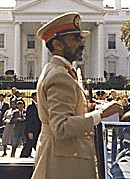Haile Selassie I Facts for Kids
Haile Selassie I was the Emperor of Ethiopia from 1930 to 1974, known for his modernization efforts, resistance against colonialism, and global influence.
View Article For:

Related Articles
Introduction
Rise To Power
He was only 24 years old! He worked hard to improve the country’s laws and better the lives of the Ethiopian people. 🎉
People respected him, and he became the Emperor in 1930. He aimed to modernize Ethiopia, introducing new things like roads and schools. Also, he was the first African ruler to speak to the League of Nations in 1936, asking for help against an invasion by Italy! This made him famous worldwide. 🌍
Exile And Return
He went to live in exile in England, where he continued to speak for the rights of his people. After several years, he made a triumphant return to Ethiopia. However, the situation had changed, and the military government had taken over. Despite being back in his beloved country, he was not able to rule anymore. Sadly, he was detained and died in 1975. Even though he faced difficulties, people remember him as a hero in Ethiopia's history!
Reign As Emperor
During his reign, he focused on education and healthcare. He built hospitals, schools, and improved infrastructure. Selassie was a kind leader who wanted everyone to have opportunities. He hosted treaties with other nations to strengthen Ethiopia's position in Africa. He also encouraged women's rights, giving them the chance to attend school and work jobs. Even though he faced challenges, like invasions, he stood strong for his people. His dedication made Ethiopia one of the first African nations to resist colonization successfully!
Legacy And Impact
His efforts to modernize the country and promote education had a lasting impact. Today, his legacy is celebrated, especially in Rastafarian culture, where he is seen as a symbol of hope and freedom. His speeches about unity and independence inspire many people across the globe. He is also remembered for standing up to colonization and advocating for African nations. As the first African leader to speak at the UN, he left a mark that shows the importance of representation!
Religious Leadership
️ As a Christian, he played an essential role in the Ethiopian Orthodox Church, which is one of the oldest Christian communities in the world. He promoted peace and love among all religions. Many Rastafarians believe Haile Selassie is a divine figure and see him as a symbol of hope and resistance. His commitment to religious tolerance helped strengthen Ethiopia's diverse communities. His teachings continue to inspire people in their spiritual journeys, reflecting unity and understanding!
Cultural Significance
He encouraged traditional music and dance, which are still enjoyed today. His reign brought attention to Ethiopian art and history, highlighting the country’s rich heritage. Many festivals celebrate his life, bringing people together to honor their culture! Additionally, his story inspired many writers, musicians, and artists around the world, and he is often featured in songs and movies. Through these cultural elements, his memory lives on in the hearts of many!
Early Life And Education
He came from a royal family, so he learned many important skills at a young age. By 9 years old, he was sent to the capital city, Addis Ababa, to study. 📚
There, he gained knowledge about history, science, and languages, including Amharic and French! He loved learning and wanted to make Ethiopia a better place for everyone. After finishing school, he became a governor and showed remarkable leadership. His early life helped shape him into a great leader for Ethiopia!
Controversies And Criticisms
Some people believed he didn't do enough to help the poor. Others said he ruled too much like a king rather than allowing more democracy. There were protests against his government, and some people felt his responses were too harsh. 📉
After his exile, problems in the country continued, leading to public disagreements about his leadership. Nevertheless, many still admire him for his efforts to modernize Ethiopia and improve the lives of its citizens, showing that even great leaders can have controversies.
Global Influence And Diplomacy
He believed in peace and worked with many countries, including the United Nations. In 1963, he helped establish the Organization of African Unity (OAU), which aimed to improve cooperation among African nations. 🌍
He was a key player in promoting unity on the continent, fighting against colonialism. Haile Selassie loved sharing Ethiopian culture and traditions, which helped the country gain attention and respect from other nations. His influence inspired movements for independence in many African countries!
Modernization Efforts In Ethiopia
He launched many modernization projects. Roads, railways, and communication systems were built to connect cities and towns. He also improved education by creating new schools. 📚
The Emperor wanted everyone, including women, to have opportunities for learning. Agriculture was modernized with new farming techniques, which helped feed the people. Selassie's goal was to make Ethiopia a strong and developed country by embracing new ideas and technology to improve the lives of its citizens!
DIY is a humongous library of
activities and courses for kids.
Curious?
Gallery of
Did you know?
🇪🇹 Haile Selassie I was the Emperor of Ethiopia from 1930 to 1974.
🍼 He was born on July 23, 1892, in Ejersa Gora, Ethiopia.
✊ He became the leader of Ethiopia at just 24 years old in 1916.
🌍 Selassie was the first African ruler to speak to the League of Nations in 1936.
🌟 During his reign, he focused on improving education and healthcare in Ethiopia.
🚀 He launched modernization projects that included building roads and schools.
😢 In 1974, he was forced into exile by military leaders.
🏆 Haile Selassie's legacy is celebrated, especially in Rastafarian culture.
🎶 He encouraged traditional music and arts as part of Ethiopian culture.
✝️ Selassie was a Christian leader who promoted peace among different religions.







